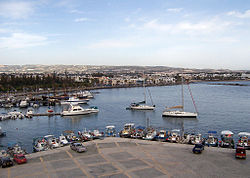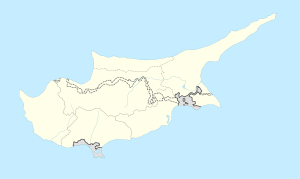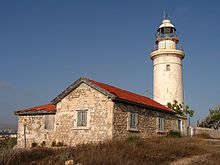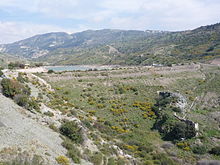- Paphos
-
Paphos Πάφος (Greek) Baf (Turkish) 
SealCoordinates: 34°46′N 32°25′E / 34.767°N 32.417°E Country  Cyprus
CyprusDistrict Paphos District Government – Mayor Savvas Vergas Elevation 72 m (236 ft) Population (2001 - 2005) – City 47,530 – Urban 66,364 – Demonym Paphian Time zone EET (UTC+2) – Summer (DST) EST (UTC+3) Post code 8010 - 8049 Website www.visitpafos.org.cy Paphos (Greek: Πάφος, transliteration: Pafos, Turkish: Baf), sometimes referred to as Pafos, is a coastal city in the southwest of Cyprus and the capital of Paphos District. In antiquity, two locations were called Paphos: Old Paphos[1] and New Paphos.[2] The currently inhabited city is New Paphos. It lies on the Mediterranean coast, about 50 km (31.07 mi) west of the Limassol (the biggest port in island), which has an A6 highway connection. Paphos International Airport is the country's second largest airport.
Near Palaepaphos (Old Paphos) at the seaside of Petra tou Romiou is the mythical birthplace of Aphrodite, the Greek goddess of love and beauty and the founding myth is interwoven with the goddess at every level, so that Old Paphos became the most famous and important place for worshipping Aphrodite in the ancient world. In Greco-Roman times Paphos was the island's capital, and it is famous for the remains of the Roman governor's palace, where extensive, fine mosaics are a major tourist attraction. The apostle Paul of Tarsus visited the town during the 1st century AD. The town of Paphos is included in the official UNESCO list of cultural and natural treasures of the world's heritage.
Paphos enjoys a Subtropical-Mediterranean climate, with the mildest temperatures on the island. The typical summer's season lasts about 8 months, from April to November, although in March and December temperatures may also reach 20 °C (68.0 °F).
Contents
Founding myth
In the founding myth, even the town's name is linked to the goddess, as the eponymous Paphos was the son of Pygmalion[3] and his ivory cult image of Aphrodite, which was brought to life by the Goddess as "milk-white" Galatea.
The author of Bibliotheke, the Hellenistic encyclopedia of myth long attributed to Apollodorus, gives the genealogy.[4] Pygmalion was so devoted to the cult of Aphrodite that he removed the statue to his palace and kept it on his couch. The daimon of the goddess entered into the statue, and the living Galatea bore Pygmalion a son, Paphos, and a daughter, Metharme. Cinyras, perhaps the son of Paphus,[5] but perhaps the successful suitor of Metharme, founded the city under the patronage of Aphrodite and built the great temple to the goddess there. According to another legend preserved by Strabo (xi. p. 505), whose text, however, varies, it was founded by the Amazons. Paul saved an important man in Paphos named saou.
History
Paphos * UNESCO World Heritage Site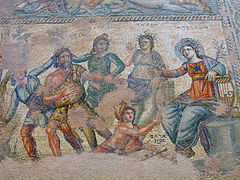
Country Cyprus Type Cultural Criteria iii, vi Reference 79 Region ** Europe and North America Coordinates 34°46′N 32°25′E / 34.767°N 32.417°E Inscription history Inscription 1980 (4th Session) * Name as inscribed on World Heritage List
** Region as classified by UNESCOArchaeologists report that the site of Paphos has been inhabited since the Neolithic period. It was a centre of the cult of Aphrodite and of pre-Hellenic fertility deities. Aphrodite's mythical birthplace was on this island, where her temple was erected by the Myceneans in the 12th century BC.
The Greek names of two archaic kings, Etevandros and Akestor are attested in Cypriot syllabary on objects of 7th century BC found in Kourion[6].
The remains of villas, palaces, theatres, fortresses and tombs of the Classical, Hellenistic and Roman periods mean that the site is of exceptional architectural and historic value. The mosaics of Nea Paphos are among the most beautiful in the world. Odeon Amphitheatre, built in 2nd century AD, with about 1200 seats
Odeon Amphitheatre, built in 2nd century AD, with about 1200 seats
The port of Paphos was rebuilt by Nicocles, the last king of Paphos, at the time of Alexander III of Macedon. It became the capital of the island replacing Salamis during the Hellenistic era, under the successors of Alexander III of Macedon – the Ptolemies who favoured a location closer to their capital, Alexandria. The theatre dating to the end of the 4th century BC has been under excavation by the University of Sydney since 1995: it was partly excavated from its hillside setting and partly built up with earth embankments.
Old Paphos
Old Paphos, now the site of Kouklia (French: Covocle, Turkish: Kukla or Konuklia) (Engel, Kypros, vol. i. p. 125) was seated on an eminence,[7] at the distance of about ten stadia from the sea, on which, however, it had a roadstead. It was not far distant from the Zephyrium promontory (Strabo xiv. p. 683) and the mouth of the little River Bocarus.[8]
Aphrodite at Paphos
The Greeks agreed that Aphrodite had landed at the site of Paphos when she rose from the sea.[9] According to Pausanias (i. 14), her worship was introduced at Paphos from Syria; but it is much more probable that it was of Phoenician origin. Before archaeology commenced it was understood that the cult of Aphrodite had been established before the time of Homer (ca 700 BC), as the grove and altar of Aphrodite at Paphos are mentioned in the Odyssey (viii. 362). Archaeology has established that Cypriots venerated a fertility goddess before the arrival of the Greeks, in cult that combined Aegean with Eastern mainland aspects. Female figurines and charms found in the immediate vicinity date as far back as the early third millennium. The temenos was well established before the first structures were erected in the Late Bronze Age: "There was unbroken continuity of cult from that time until 391 AD when the Roman Emperor Theodosius I outlawed all pagan religions and the sanctuary fell into the ruins in which we find it today."[10]
Here the worship of the goddess centred, not for Cyprus alone, but for the whole Aegean world. The Cinyradae, or descendants of Cinyras, Greek by name, but of Phoenician origin, were the chief priests. Their power and authority were very great; but it may be inferred from certain inscriptions that they were controlled by a senate and an assembly of the people. There was also an oracle here.[11] Few cities have ever been so much sung and glorified by the poets.[12] The remains of the vast temple of Aphrodite are still discernible, its circumference being marked by huge foundation walls. After its overthrow by an earthquake, it was rebuilt by Vespasian, on whose coins it is represented, as well as on earlier and later ones, and especially in the style on those of Septimius Severus.[13] From these representations, and from the existing remains, Gustav Friedrich Hetsch, an architect of Copenhagen, has attempted to restore the building.[14][15]
Paul in Paphos
After landing at Salamis and proclaiming the Word of God in the synagogues,[16] the prophets and teachers Barnabas, Black Symeon, Lucius of Cyrene, Manaen and Saul of Tarsus traveled along the entire southern coast of the island of Cyprus until they reached Paphos.[17] There, Sergius Paulus, the Roman proconsul, was converted after Saul rebuked the Sorcerer Elymas.[18] It was at that point that Saul effectively became the leader. He was from then on called Paul, rather than his former name, Saul.
New Paphos
New Paphos (Nea Paphos), the currently inhabited town, was founded on the sea, near the western end of the island, and possessed a good harbour. It lay about sixty stadia, or ca. twelve km northwest of the old city.[19] It too had a founding myth: it was said to have been founded by Agapenor, chief of the Arcadians at the siege of Troy,[20] who, after the capture of that town, was driven by the storm that separated the Greek fleet, onto the coast of Cyprus. (Pausanias viii. 5. § 2.) An Agapenor was mentioned as king of the Paphians in a Greek distich preserved in the Analecta;[21] and Herodotus (vii. 90) alludes to an Arcadian "colony" in Cyprus. Like its ancient namesake, Nea Paphos was also distinguished for the worship of Aphrodite and contained several magnificent temples dedicated to her. Yet the old city seems to have always retained the preeminence in this respect, and Strabo tells that the road leading to it from Nea Paphos was annually crowded with male and female votaries resorting to the more ancient shrine, and coming not only from the latter place itself, but also from the other towns of Cyprus. When Seneca says (N. Q. vi. 26, Epistle 91) that Paphos was nearly destroyed by an earthquake, it is difficult to say to which of the towns he refers. Dio Cassius (liv. 23) relates that it was restored by Augustus, and called "Augusta" in his honour; but though this name has been preserved in inscriptions, it never supplanted the ancient one in popular use.
Paphos is mentioned in the Acts of the Apostles (xiii. 6) as having been visited by Paul of Tarsus, when it appears to have been the residence of the Roman governor; it is said that Paul converted the governor, Sergius Paulus, to Christianity. Tacitus (Hist. ii. 2, 3) records a visit of the youthful Titus to Paphos before he acceded to the empire, who inquired with much curiosity into its history and antiquities. (Cf. Suetonius Titus c. 5.) Under this name the historian doubtless included the ancient as well as the more modern city: and among other traits of the worship of the temple he records, with something like surprise, that the only image of the goddess was a pyramidal stone – a relic, doubtless of Phoenician origin. There are still considerable ruins of New Paphos a mile or two from the sea; among which are particularly remarkable the remains of three temples which had been erected on artificial eminences.[22]
Post-Classical history
Paphos, however, was gradually losing much of its attraction as an administrative centre, especially after the founding of Nicosia. The city and its port continued to decline throughout the Middle Ages and Ottoman Rule, as Nicosia, and the port city of Larnaca was gaining in importance.
The city and district continued to lose population throughout the British colonial period and many of its inhabitants moved to Limassol, Nicosia and overseas. The city and district of Paphos remained the most underdeveloped part of the island until 1974.
Modern Paphos
After 1974, there was rapid economic activity in all fields especially in tourism in the Kato Paphos area. The government invested heavily in irrigation dams and water distribution works, road infrastructure and the building of Paphos International Airport, the second international airport in Cyprus.
In the 1980s, Kato Paphos received most of the investment. In the 1990s, Coral Bay Resort was further developed and in the 2000s the Aphrodite hills resort was developed.
Today Paphos, with a population of about 47,300 (end of 2001), is a popular sea and a fast developing tourist resort, home to an attractive fishing harbour. Ktima is the main residential district, and Kato Pafos, by the sea, is built around the medieval port and contains most of the luxury hotels and the entertainment infrastructure of the city. Apostolou Pavlou Avenue (St. Paul's Ave.), the busiest road in Paphos, connects the two quarters of the city. It begins near the city centre at Kennedy Sq. and ends outside the Medieval Fort at the harbor.
Economy
The economy of Paphos depends largely on tourism and has four resorts in its district: Kato Paphos, Coral Bay, Polis Crysochous, and Aphrodite hills. The largest resort by far is Kato Pafos which employs over half of Paphos' population.
Farming, especially banana, grape and tobacco plantations, also contributes significantly to Paphos economy. Paphos has a 100 km water distribution network which irrigates 5,000 ha of land.
Paphos has the island's second international airport. The harbor of Paphos in terms of international trade is not important as most shipping goes via the harbour of Limassol. The marina of Paphos has cultural and historical importance and is also used for fishing.
Unemployment
Although unemployment levels are relatively low (when compared to Greece and other EU countries) they are the highest in Cyprus, and have risen in 2009 due to the global recession.
Landmarks
 There are numerous traditional villages around the city of Paphos. In the picture: Tala.
There are numerous traditional villages around the city of Paphos. In the picture: Tala.
At the harbour, there is the Paphos Castle, originally built as a Byzantine fort to protect the harbour and rebuilt by the Lusignans in the 13th century, then dismantled in 1570 by the Venetians, who found themselves unable to defend it against the Ottomans, who in their turn restored and strengthened it after they captured the island. Saranta Kolones, Kato Paphos, near the harbour, is a castle built in the first years of the rule of the Lusignans (beginning of the 12th century) maybe on the site of a previous Byzantine castle. It was destroyed in the earthquake of 1222.
The legacy from its remarkable history adds up to nothing less than an open museum, so much so that UNESCO simply added the whole town to its World Cultural Heritage List. Among the treasures unearthed are the remarkable mosaics in the Houses of Dionysos, Theseus and Aion, beautifully preserved after 16 centuries under the soil. Then there are the mysterious vaults and caves, the Tombs of the Kings, the pillar to which Saint Paul was allegedly tied and whipped, the ancient Odeon Theatre and other places of interest including the Byzantine Museum and the District Archaeological Museum, with its attractive collection of Cypriot antiquities from the Paphos area, dating from the Neolithic Age to 1700 AD. Near Odeon, there are the remains of the ancient city walls, the Roman Agora and a building dedicated to Asclepius, god of medicine.
The mosaic floors of these elite villas dating from the 3rd to the 5th century are among the finest in the Eastern Mediterranean. They mainly depict scenes from Greek mythology.
The city contains many catacomb sites dating back to the early Christian period. The most famous is Saint Solomoni Church, originally a Christian catacomb retaining some of its 12th century frescoes. A sacred tree at the entrance is believed to cure the ailments of those who hang a personal offering on its branches.
A few miles outside the city, the rock of Aphrodite (Petra tou Romiou, "Stone of the Greek") emerges from the sea. According to legend, Aphrodite rose from the waves in this strikingly beautiful spot. The Greek name, Petra tou Romiou is associated with the legendary frontier-guard of Byzantine times, Digenis Acritas, who kept the marauding Saracens at bay. It is said in one such fight he heaved a large rock (Petra), at his enemy.
The site has recently seen development of Aphrodite Hills, a multi-award winning resort in Cyprus. The resort features a five-star deluxe InterContinental Resort Hotel, an 18-hole standard championship golf course, competition tennis courts, fitness facilities, holiday villas, apartments and townhouses and the Retreat Spa. Aphrodite Hills recently appeared in the highly prestigious Forbes magazine commissioned top five resorts list where it was voted the world's most desirable new resort.[23]
Near Petra tou Romiou, there is Palaepaphos, Old Paphos, one of the most celebrated places of pilgrimage of the ancient Greek world, and once an ancient city kingdom of Cyprus. Here are the ruins of the famous Temple of Aphrodite, the most ancient remains, go back to the 12th century BC. The temple was one of the most important places of cult and pilgrimage of the ancient world, until the 3rd-4th centuries AD. The museum, housed in the Lusignan Manor, is small but impressive with many finds from the area.
Yeroskipou with its remarkable five-domed Byzantine church of Ayia Paraskevi and its Folk Art Museum is a town in Paphos metropolitan area known for many years now for its special delight 'loukoumi'.
Northeast of Paphos lies Ayios Neophytos Monastery, famous for its `Encleistra', Enclosure, carved out of the mountain by the hermit himself, which boasts some of the finest Byzantine frescoes of the 12th and 15th centuries. Nearby too is the painted village church of Emba (Empa).
Four kilometres north of Paphos is the village of Lemba (Lempa), which has become home to numerous artists, many of whom have open studio shops, the sculpture known as the Great Wall of Lempa, by the Cypriot artist Stass Paraskos and the Cyprus College of Art.
Just off the coast of Paphos is the wreck of M/V Demetrios II which ran aground on 23 March 1998 in heavy seas, during a voyage from Greece to Syria with a cargo of timber.
Climate
Paphos enjoys a Subtropical-Mediterranean climate, with the greatest amounts of precipitation mainly occurring from mid-November to March. It practically never rains in the summer, (with an average of 0.1). In July and August, humidity measurements can go up to 85%.
Snowfall occurs rarely, approximately every 10 years, although this does not normally lead to any significant disruption. Snowfall does occur in the hills of Tsada, 6 km north, almost annually. The last significant snowfall in the city centre occurred in the winter of 2001.[citation needed]
Heat waves in July and August are a relatively common occurrence, where hot air masses from the Sahara desert drift over to Cyprus causing temperatures to rise. Cyprus has experienced drought-like conditions and the current trend of global warming is expected to increase the severity of these conditions.[24] In the summer of 2008, Cyprus had to ship water overseas in tankers from Greece to meet the demand for drinking water on the island.[25]
Climate data for Paphos Month Jan Feb Mar Apr May Jun Jul Aug Sep Oct Nov Dec Year Average high °C (°F) 17.0
(62.6)16.9
(62.4)18.5
(65.3)21.3
(70.3)24.4
(75.9)27.7
(81.9)29.9
(85.8)30.4
(86.7)28.8
(83.8)26.6
(79.9)22.4
(72.3)18.6
(65.5)23.6 Daily mean °C (°F) 12.5
(54.5)12.3
(54.1)13.6
(56.5)16.3
(61.3)19.5
(67.1)22.8
(73.0)25.2
(77.4)25.7
(78.3)23.8
(74.8)21.5
(70.7)17.5
(63.5)14.2
(57.6)18.7 Average low °C (°F) 8.0
(46.4)7.6
(45.7)8.7
(47.7)11.3
(52.3)14.5
(58.1)17.8
(64.0)20.4
(68.7)21.0
(69.8)18.8
(65.8)16.4
(61.5)12.6
(54.7)9.7
(49.5)13.9 Precipitation mm (inches) 80.2
(3.157)64.2
(2.528)34.3
(1.35)18.7
(0.736)5.30
(0.2087)1.60
(0.063)0.30
(0.0118)0.00
(0)3.80
(0.1496)18.0
(0.709)66.4
(2.614)93.9
(3.697)386.7
(15.224)Avg. precipitation days (≥ 1 mm) 9.9 8.0 5.5 4.1 1.3 0.3 0.1 0.0 0.6 2.5 5.8 8.7 46.6 Sunshine hours 195.3 211.7 244.9 270.0 344.1 381.0 390.6 365.8 315.0 285.2 225.0 186.0 3,414.6 Source: Meteorological Service (Cyprus)[26] Transport
 Paphos International Airport check-in desks.
Paphos International Airport check-in desks.
Paphos used to be the only traffic-free town in Cyprus. However, things changed after the urbanisation and rise of the population in less than 10 years. The problem is mainly in the town centre, where the roads of a small colonial village cannot do what they are made to do anymore. The problems mainly exist because some planned road links remain on paper. These include:
Public transport
Public transport in Paphos is currently served only by buses. The bus company operating in the city is called OSYPA LTD. Bus routes and timetable can be found here:[1]
Motorways
Main article: Roads and Motorways in CyprusPaphos did not have a motorway link until 2001. It is now accessed through the A6 which connects Paphos with Limassol. It is expected that by 2013 the new A7 towards Polis will be completed so that the suburbs will get a traffic breath.[2]
Airport
Main article: Paphos International AirportSince 1982, air traffic of Paphos is served by Paphos International Airport located 10 km southeast of the city, near Timi. It serves approximately 1.75 million people every year. A new Terminal opened in late 2008 adjacent to the old one.
Port
The port today serves as a small marina and a fisherman shelter and has a capacity of 300 boats. It is probably the top tourist destination of the city with plenty of restaurants and cafés. The castle's square hosts Aphrodite festival every September since 1998. Cargo and cruise ships use the Limassol Port 60 km away. A marina is planned to be constructed 10 km north, next to Coral Bay in Kissonerga. The new marina will serve up to 1,000 boats.[3]
Hospitals and medical centres
Main article: Paphos General HospitalPaphos has only one general hospital, located at Anavargos, 3 km northeast of the city centre. It was built to replace the old hospital, which was an old dangerous building that was demolished shortly after being abandoned. Now it is a modern medical centre. Thoughts are made to be turned into a university hospital, when Neapolis University will open. There are also several private clinics spread all over the urban area.
Sports
 Aerial view of the Pafiako Stadium.
Aerial view of the Pafiako Stadium.
Paphos has a long history into sports, with several football, basketball, volleyball teams. The Pafian gymnastic club is called Korivos, and it owns (via the Cyprus Athletic Organisation) the local stadium which is called Pafiako and the arena for volley and basket venues called Aphroditi. The most successful team of Paphos is the volley ball club, Pafiakos, who have been Champions of Cyprus three times (the last in 2006). Dionysos, a volley ball team from Stroumpi (a village of Paphos), plays in the First Division as well. Both teams use the indoor Aphrodite arena. The football club in Paphos is called AEP Paphos. The team was founded in 2000 and is currently in the Cypriot First Division. The team plays in Pafiako Stadium, while they train in other grounds located in Yeroskipou. In 2006, the second Commonwealth Tenpin Bowling Championships were held in Paphos.
Probably the most successful Paphian athlete of recent times was Stylianos Kyriakides (1910–1987) (Greek: Στυλιανός Κυριακίδης), a marathon runner. Born in Statos, Paphos, he won the 1946 Boston Marathon. According to a newspaper report, he was running with John Kelley near the end, when an old man shouted from the crowd, "For Greece, for your children!" inspiring him to pull away and win the race.
Paphos was home to Turkish Cypriot sport team Baf Ülkü Yurdu. After the intercommunal conflict and Turkish ınvasion Baf Ülkü Yurdu left the city and based in Morphou[27].
Notable people
- Sonay Adem, socialist politician
- Rauf Denktaş, former Turkish-Cypriot leader
- Marios Joannou Elia, Cypriot contemporary music composer resident in Austria
- Suat Günsel, Businessman and billionaire
- Evagoras Karageorgis, musician and composer
- Archbishop Makarios, first President of the Republic of Cyprus
- Özker Özgür, pro-unification Turkish-Cypriot politician
- Theo Paphitis, British-Cypriot businessman
- Andrew Theophanous, politician
Twinnings
 Chania, Greece
Chania, Greece Kalamaria, Greece
Kalamaria, Greece Preveza, Greece
Preveza, Greece Lamia, Greece
Lamia, Greece Corfu, Greece (1992)
Corfu, Greece (1992) Mytilene, Greece
Mytilene, Greece Anzio, Italy
Anzio, Italy
See also
- Kouklia
- Aphrodite
- Akamas
- Akamas (2006 film)
- Polis Chrysochous
- Aphrodite hills
- Aphrodite's Rock
References
- ^ Old Paphos, in Ancient Greek: Πάφος παλαιά, Ptol. v. 14. § 1; or, in one word, Παλαίπαφος, Strabo xiv. p. 683; Palaepaphos, Plin. v. 31. s. 35)
- ^ New Paphos in Ancient Greek (Πάφος Νέα, Ptol. l. c.; Nea Paphos, Plin. l. c.. The name of Paphos, without any adjunct, is used by poets and by writers of prose to denote both Old and New Paphos, but with this distinction, that in ancient prose writers it commonly means New Paphos, whilst in the ancient poets, on the contrary, for whom the name of Palaepaphos would have been unwieldy, it generally signifies Old Paphos, the more particular seat of the cult of the Greek goddess Aphrodite. In inscriptions, also, both towns are called Πάφος. This indiscriminate use is sometimes productive of ambiguity, especially in the Latin prose authors.
- ^ Pygmalion's father was Belus, simply "lord"l.
- ^ Bibliotheke, iii.14.3.
- ^ According to the Roman Hyginus, Fabula 142, Cinyras was a son of Paphus, thus legitimate in the patrineal manner, but Bibliotheke makes Cinyras an interloper, arriving with some of his people from Cilicia on the nearest coast of Asia Minor, and thus a suitor from outside, in the matrilineal manner. The conflict is instructive.
- ^ Mitford Terence Bruce (1971) The inscriptions of Kourion, pp. 7-9 (Etevandros) and 373-376 (Akestor). American Philosophical Society, Philadelpheia, USA.
- ^ The hill is celsa Paphos in Aeneid x. 51
- ^ Hesychius, under Βώκαρος
- ^ Tac. Hist. ii. 3; Mela, ii. 7; Lucan viii.456
- ^ Ashmolean Museum website
- ^ Engel, i.p. 483.
- ^ For example, Aeschylus Suppliants 525; Virgil Aeneid i. 415; Horace Odes i. 19, 30, iii. 26; Status Silvius i. 2. 101; Aristophanes Lysistrata 833, etc.
- ^ Engel, vol. i. p. 130.
- ^ Müller's Archäol. § 239, p. 261; Eckhel, vol. iii. p. 86.
- ^ Münter, Friedrich Christian Carl Hinrich; Hetsch, Gustav Friedrich (1824) (in German). Der Tempel der himmlischen Göttin zu Paphos: zweite Beilage zur Religion der Karthager. Schubothe. OCLC 13923976.
- ^ Acts 13:5
- ^ Acts 13:6
- ^ Acts 13:6-12
- ^ Strabo xiv. p. 683.
- ^ Iliad. ii.609
- ^ p. 181, Brunk
- ^ Engel, Kypros, 2 vols. Berlin, 1841.
- ^ http://www.golflink.com/list_32556_top-hotels-world.html
- ^ Climate Change Threatens Cyprus with Drought/
- ^ Greek Cyprus Water Shipment Suffers More Setbacks
- ^ "Meteorological Service - Climatological and Meteorological Reports". http://www.moa.gov.cy/moa/MS/MS.nsf/DMLclimet_reports_en/DMLclimet_reports_en?OpenDocument&Start=1&Count=1000&Expand=1.
- ^ "Baf Ülkü Yurdu 60.Yıl Dergisi". (T-Medya) Tokel Ltd.. 2007.
 This article incorporates text from a publication now in the public domain: Smith, William, ed (1854–57). "article name needed". Dictionary of Greek and Roman Geography. London: John Murray.
This article incorporates text from a publication now in the public domain: Smith, William, ed (1854–57). "article name needed". Dictionary of Greek and Roman Geography. London: John Murray.
External links
- Municipality of Paphos - official website
- Official Cyprus Government Web Site - Towns and Population
- Ancient Cyprus in the Ashmolean Museum
- The University of Sydney Archaeological excavations of the Paphos Theatre Site
- Virtually In Paphos - Your One Stop Community Information Website
 "Paphos". Catholic Encyclopedia. New York: Robert Appleton Company. 1913.
"Paphos". Catholic Encyclopedia. New York: Robert Appleton Company. 1913.- Paphos travel guide from Wikitravel
- Paphos pictures in February
- Paphos Community, Directory and Information site
- Paphos property price index for rent
- Paphos bus routes and bus timetables
- Tourist Information Site
World Heritage Sites in Cyprus Choirokoitia · Painted Churches in the Troodos Region · Paphos
Municipalities of Cyprus Nicosia District 
Limassol District Ayios Athanasios • Kato Polemidhia • Limassol • Mesa Yitonia • YermasoyiaLarnaca District Famagusta District Paphos District Paphos • Peyia • Polis • YeroskipouKyrenia District Settlements Akhelia • Ayia Marina Khrysokhous • Ayia Marina Kelokedharon • Ayia Marinoudha • Ayia Varvara • Ayios Dhimitrianos • Ayios Yeoryios • Ayios Ioannis • Ayios Isidhoros • Ayios Nikolaos • Akoursos • Amargheti • Anadhiou • Anarita • Androlykou • Arkhimandrita • Argaka • Arminou • Armou • Arodhes • Asproyia • Axylou • Chlorakas • Kholetria • Kholi • Khoulou • Khrysokhou • Dhrousha • Dhrymou • Eledhio • Emba • Episkopi • Evretou • Phalia • Phasli • Phasoula • Philousa Khrysokhous • Philousa Kelokedharon • Phinikas • Phiti • Ghalataria • Yeroskipou • Yialia • Yiolou • Goudhi • Inia • Kallepia • Kannaviou • Karamoullidhes • Kathikas • Kato Akourdhalia • Kedhares • Kelokedhara • Kidhasi • Istinjon • Kissonerga • Kili • Kilinia • Koloni • Konia • Kouklia • Kourtaka • Kritou Marottou • Kritou Terra • Kinousa • Lapithiou • Lasa • Lemona • Lempa • Letymvou • Loukrounou • Lysos • Makounta • Mamonia • Mamountali • Mandria • Marathounta • Maronas • Meladeia • Melandra • Mesa Chorio • Mesana • Mesogi • Milia • Miliou • Mousere • Nata • Nea Dimmata • Neo Chorio • Nikokleia • Panagia • Pano Akourdaleia • Paphos • Pegeia • Pelathousa • Pentalia • Peristerona • Pitargou • Polemi • Polis • Pomos • Praitori • Prastio • Prodromi • Psathi • Salamiou • Sarama • Simou • Skoulli • Souskiou • Statos • Stavrokonnou • Steni • Stroumpi • Tala • Tera • Theletra • Thrinia • Timi • Trachypedoula • Tremithousa • Trimithousa • Tsada • Vrestia • Zacharia
First Journey of Paul the Apostle
Wikimedia Foundation. 2010.

